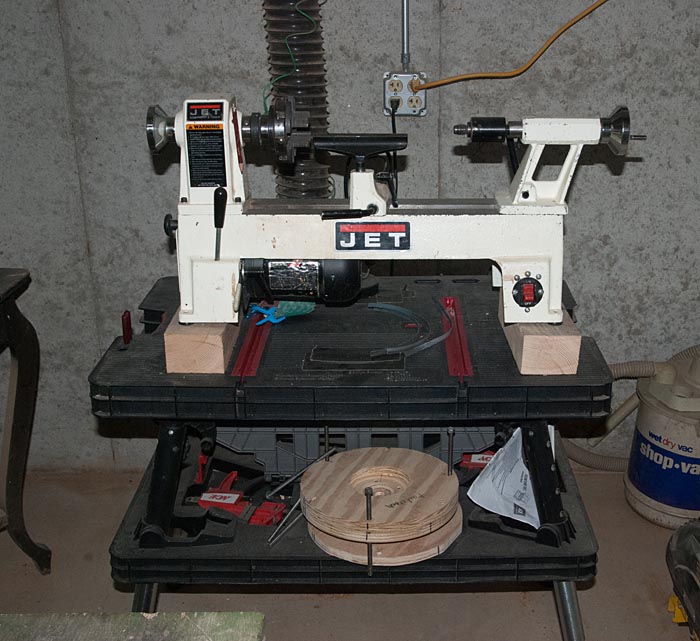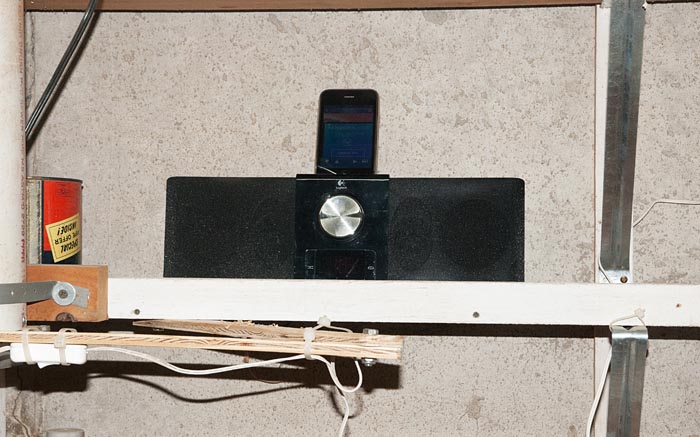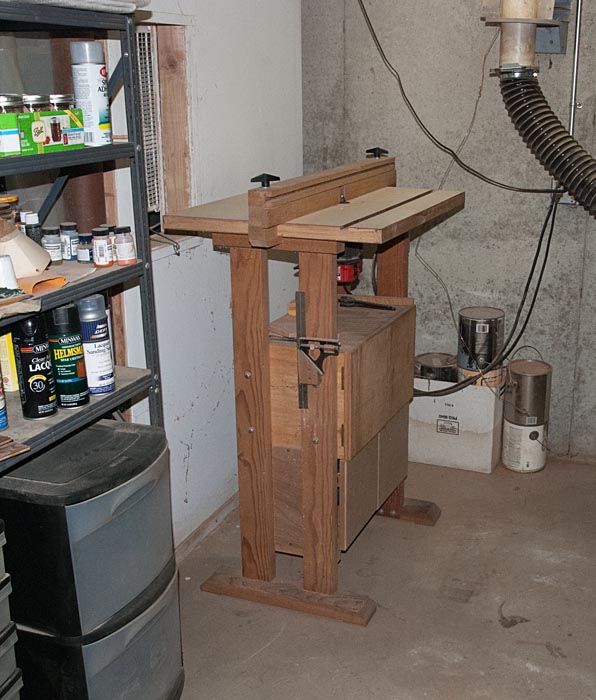Rick_Bryant_shop_tour
Tour of Rick Bryants shop November 2015.
We start entering “Ricks Studio”. The sign was made by Ricks sister.

Ricks Studio, entrance to his shop
To the left of the sign is a nice looking large platter. Rick turned this on his first lathe, a NOVA 3000. I did not measure but this is at about 30in diameter. Quite a good turning on any lathe.

Large platter turned on NOVA 3000 lathe
Inside the shop we see Rick turning at his Powermatic lathe.

Rick turning on his Powermatic lathe
Rick pays a lot of attention to dust and particle collection. He has two air cleaners. For readers who may not know, air cleaners help the lungs by removing fine dust particles.
Dust collection, shop vacuums help to keep the shop clean but do not remove the small particles which can cause respiratory problems in later years.

First air cleaner, a Delta unit
The second air cleaner.

Second air cleaner a JDS unit
Rick has a heavy plastic floor-to-ceiling curtain around his lathe to keep most of the dust within the turning space.
In this picture to the right of the lathe a box fan in the wall directs air towards the lathe. Rick has a home made mobile tool storage cart. The plastic curtain is shown behind the cart

Box fan, tool cart and plastic curtain
To the left of the lathe is another box fan which directs the air out of the turning area so the air flows from right to left. Rick says this takes most of the dust away from him while turning.

Box fan exhausting air
On the other side of the exhaust fan Rick has a filter to collect larger particles/dust. A normal home AC filter.

Exhaust fan filter
The main dust collection system is a Penn State Cyclone which Rick built from a Penn State kit.

Cyclone dust collector
The cyclone is in the same room as the storage for rough turned bowls and some log sections.

Log section storage

Rough turned bowls
In this room Rick has a simple hood for taking pictures of his turnings.

Photo hood
Ricks air compressor is a small portable unit. This is one of the few tools he would like to upgrade to one with bigger tank and air flow.

Portable air compressor
Rick has a wide range of machines and tools, some for flatwork and some for turning. He does not do much flatwork these days.
A Jet mini-lathe.

Jet mini lathe
Miter-chop saw.

Miter-chop saw
Ricks bandsaw. Very useful for cutting log sections for turning blanks.

Rikon bandsaw
A jointer.

Jointer
Some of Ricks machines are handed down from his father. Always good to see machines getting a second life.
Drill press.

Drill press
An old Rockwell contractor style table saw. They do not make them like this anymore.

Rockwell table saw
The main turning tool, Ricks Powermatic lathe.

Powermatic lathe
The lathe has a pivot style tailstock swing-away made by Butler Manufacturing. They do not seem to still be in business. A good design since it pivots horizontally so no heavy lifting to get place in place.

Tailstock swing-away
A remote start/stop switch mounted at the tailstock end. Very useful to be able to turn off the lathe without reaching across the turning project. Rick does not have a shelf under the lathe for placing the tools being used, but has two tubes to store a couple of tools.

Remote start-stop switch
Tip – do not throw away “obsolete” smartphones. Rick uses his old iPhone3 to stream music.

iPhone to stream music
Tip – make an articulated arm for a clamp on LED light. Very useful to have some spot lighting on the turning. Rick got this idea from Mike Kehs.

LED articulated light
I love re-purposing items. Rick has an excellent re-purpose example. He found an IV bag hanger thrown out on the side of the road as garbage. He took this home and it makes a terrific stand for his Wecheer rotary tool equipment.

Wecheer equipment
Rick likes his David Elsworth hollowing tools for the simplicity and they work well for him. I was surprised at the length. This one is a straight tool tip. The other one in the lower right has angled tool tip.

Straight hollowing tool
Rick has even more turning tools at the end of a bench. He uses the scrapers and roughing gouge a lot. Rick does have a lot more tools than I have, but admits he mostly uses a few. The holes in the tubes are to provide access to screw the tubes to the backing board.

More tool storage
On the bench Rick displays a number of wall thickness gauges. The one on the left has a measurement scale, not easy to see in the picture. Rick prefers the simple wire gauges since easy and fast to use.

Wall thickness gauges
Rick does a quick demonstration on how he uses the wire gauges. The hook end is pressed against the inside wall and moved down the turning. Rick then watches the space to the other end to look for consistent spacing.

Using wall thickness gauge
The other side of this bench has a collection of dyes.

Various dyes
A couple of examples of Rick trying to emphasize the crotch grain on platters with dyes.

Dyed platters
Round the corner we have another tool from Ricks father, a router table. Rick made the fence.

Router table
Next to the router table is a large belt/disc sander.

Large belt-disc sander
Looking back on the main wall Ricks home made hollowing bar. The plans for this are in the Project page, first link.

Home made hollowing bar
Next is a conventional grinder.

Abrasive wheel grinder
Rick recently purchased a slow speed Tormek wet grinder which he likes a lot. Note the water tray is lowered for storage. Very important. If the wheel sits in the water it will wick the water all the way to the wheel shaft causing rust on the shaft. Personal experience.

Tormek wet grinder
Next we have an old dishwasher converted into a small kiln. Flood light for heat. Fan and controller not showing in the pictures. A good use for a broken dishwasher.

Old dishwasher now used as kiln
Next on the wall are dust masks including one with attached fan for the face shield.

Dust masks
Next we see some of the clamps and small parts storage.

Clamps and small parts storage
Next is the main storage bench and more tools on the wall.

Main storage bench
In the main storage bench is a McNaughton coring system.

McNaughton coring system
Next is another bench with the wood vaporizer made from a battery charger. Rick followed the plan shown in a How-To video from this page on the site. Rick says he uses the burner a lot for embellishing turnings.
Scroll down to “Make a Wood Burning Transformer“

Wood burner
I asked Rick if there are any other tools he would like to get. Other than a larger air compressor he said the only tool he does not have is a vacuum system and chucks, but then said he does not feel he needs these. I know it is possible to mount pieces without a vacuum system, but it is so much easier and faster with a vacuum system.
Thanks to Rick for the opportunity to take a tour of his shop to share with the readers.
